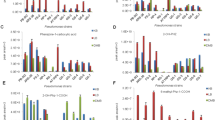Abstract
Assimilation of 99 carbon sources by eighty-eight Pseudomonas savastanoi strains isolated from oleander (41), olive (32), and various other host plants was performed. The results of numerical analysis showed that the majority of the olive and oleander strains were clustered in one phenon. Strains from other hosts such as Myrtus sp., Ligustrum sp., Phillyrea sp. and Retama sphaerocarpa, were grouped into a different phenon together with five oleander strains.
deceased on December the 16th, 2002.
Access this chapter
Tax calculation will be finalised at checkout
Purchases are for personal use only
Preview
Unable to display preview. Download preview PDF.
Similar content being viewed by others
References
Alvarez, F., Garcia de los Rios, J.E., Jimenez, P., Rojas, A., Reche, P., and Troya, M.T., 1998, Phenotypic variability in different strains of Pseudomonas syringae subsp. savastanoi isolated from different hosts. Eur. J. Plant Pathol. 104: 603–609.
Caponero, A., Contesini, A.M., and Iacobellis, N.S., 1995, Population diversity of Pseudomonas syringae subsp. savastanoi on olive and oleander. Plant Pathol. 44: 848855.
Cornai, L., and Kosuge, T., 1980, Involvement of plasmid deoxyribonucleic acid in indoleacetic acid synthesis in Pseudomonas savastanoi. J. Bacteriol. 143: 950–957.
Cornai, L., Surico, G., and Kosuge, T., 1982, Relation of plasmid DNA to indolacetic acid production in different strains of Pseudomonas syringae pv. savastanoi. J. Gen. Microbiol. 128: 2157–2163.
Garcia de los Rios, J.E., 1999, Retama sphaerocarpa (L.) Boiss., a new host of Pseudomonas savastanoi. Phytopathol. Medit. 38: 54–60.
Gardan, L., Bollet, C., Abu Ghorrah, M., Grimont, F., and Grimont, P.A.D., 1992, DNA relatedness among the pathovar strains of Pseudomonas syringae subsp. savastanoi Janse (1982) and proposal of Pseudomonas savastanoi sp. nov. Int. J. Syst. Bacteriol. 42: 606612.
Iacobellis, N.S., Contesini, A.M., and Surico, G., 1995, Bacteriocin production by Pseudomonas syringae subsp. savastanoi. Phytopathol. Medit. 34: 15–22.
Janse, J.D., 1982, Pseudomonas syringae subsp. savastanoi (ex Smith) subsp. nov., nom., rev., the bacterium causing excrescences on Oleaceae and Nerium oleander L. Int. J. Syst. Bacteriol. 32: 166–169.
Janse, J.D., 1991, Pathovars discrimination within Pseudomonas syringae subsp. savastanoi using whole-cell fatty acids and pathogenicity as criteria. Syst. Appl. Microbiol. 13: 79–84.
Mugnai, L., Giovanetti, L., Ventura, S., and Surico, G., 1994, The grouping of strains of Pseudomonas syringae subsp. savastanoi by DNA restriction fingerprinting. J. Phytopathol. 142: 209–218.
Sisto, A., Morea, M., Baruzzi, F., and Palumbo, G., 2002, Differentiation of Pseudomonas syringae subsp. savastanoi strains isolated from various host plants by restriction fragment length polymorphism. Phytopathol. Medit. 41: 63–71.
Sneath, P.H.A., and Sokal, R.R., 1973, Numerical taxonomy. The principles and practice of numerical classification. Freeman & Co., San Francisco.
Surico, G., Iacobellis, N.S., and Sisto, A., 1985, Studies on the role of indole-3-acetic acid and cytokinins in the formation of knots on olive and oleander plants by Pseudomonas syringae pv. savastanoi. Physiol. Plant Pathol. 26: 309–320.
Author information
Authors and Affiliations
Editor information
Editors and Affiliations
Rights and permissions
Copyright information
© 2003 Springer Science+Business Media Dordrecht
About this paper
Cite this paper
Bella, P., Catara, V., Sutra, L., Guarino, G., Cirvilleri, G., Gardan, L. (2003). Phenotypic Characteristics of Pseudomonas savastanoi Strains from Various Hosts. In: Iacobellis, N.S., et al. Pseudomonas syringae and related pathogens. Springer, Dordrecht. https://doi.org/10.1007/978-94-017-0133-4_75
Download citation
DOI: https://doi.org/10.1007/978-94-017-0133-4_75
Publisher Name: Springer, Dordrecht
Print ISBN: 978-90-481-6267-3
Online ISBN: 978-94-017-0133-4
eBook Packages: Springer Book Archive




